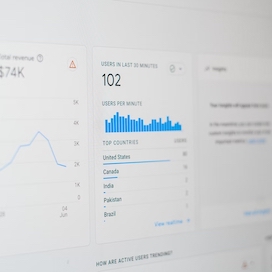Written by Ana Morales
Index
The web analytics or digital analytics is the discipline within digital marketing that allows us to measure, analyze and interpret all the traffic information that our company receives. website or mobile app from the different digital channels to understand their behavior, measure the effectiveness of our digital strategy and evaluate the achievement of business objectives in order to to make decisions to improve results.
In other words, web analytics will help you to know who are the users who come to your website and how they behave. Using this data, you will be able to analyze their experience as users of your website or app to detect friction points, opportunities for improvement and invest in the best performing traffic acquisition channels.
What can you measure with web analytics?
- Demographic data of users accessing your website: age, gender, origin, interests…
- Data about the devices, browser or operating system used.
- User behavior: which pages they visit, how long they stay on the website, recurrent users, how many pages they visit, browsing paths…
- Traffic channels: information on the sources of organic, paid, direct, social or referred traffic, among others.
- Custom events to analyze the interaction of users with the elements and pages of the website: click on CTAs, contact phone or email, form submission, file downloads…
- E-commerce and sales data: you can study the user’s purchase funnel from the moment they see a product until they complete the transaction.
- Campaign performance data.
By combining these metrics and dimensions you will be able to extract relevant information about your visitors and the user experience on your website.
The importance of web analytics to measure your business data
Web analytics is one of the fundamental pillars of your digital marketing strategy and your business, yet in many cases it remains one of the most overlooked areas of digital marketing.
Nowadays it is very common to see how after defining a marketing plan, companies invest in strategies and actions where different channels and departments are involved: SEO positioning, online advertising, inbound marketing or UX/UI. However, the online channel allows us to go one step further: measuring and evaluating results to ensure that they are aligned with business objectives and development.
Here are some examples:
- You have an e-commerce business and you have invested in an SEO audit to optimize the indexing of your website and its positioning. After a few months, you manage to increase your web visibility and your main products are in the first search results. Can you tell us the return on that investment in terms of sales results?
- You have been recommended to carry out a content marketing strategy, with the creation of new pages that reinforce the SEO campaign. You set your team to write immediately and publish articles following a schedule. Can you identify how blogging is helping to achieve business objectives?
- You want to optimize your website and you have included different forms on your website to improve the conversion rate. Can you tell which form works best and make the right decision?
All these questions have only one solution: web analytics. If you are still not convinced, we show you the main benefits of applying web analytics to your online business.
Improving the user experience on your website
In the online channel, the success of your business will depend on the experience users have once they reach your website. Digital analytics will help you to know who are the users who come to your website, which pages they visit, which ones they abandon or what path they take until they make a conversion. Thanks to this information you will be able to make changes to improve their experience and segment the most interesting audiences for your marketing actions.
Evaluate the effectiveness and efficiency of your marketing actions.
All the efforts employed in the different digital marketing strategies will be meaningless if they do not add value to our bottom line. We must analyze everything we do and measure how each action translates into business objectives. For this reason, web analytics should not be considered as an isolated and optional service, but should be integrated as part of the overall marketing strategy.
Measuring the profitability of your business according to your objectives
Web analytics helps you focus on the business objectives you have set for your online channel and keep track of your company’s growth. Before making decisions, we must know which marketing strategies are proving to be the most profitable.
Tracking and making data-driven decisions
Web analytics is not only limited to measuring, but also to extracting the data that you consider relevant for each department and decision-maker. Knowing how to analyze the data and convert it into useful information is the first step to mark the following actions.
The value provided by web analytics translates into obtaining valuable information to make the right decisions that will make your business grow.
The most widely used web analytics tools
Google Analytics
Google Analytics is the free Google tool most widely used by companies. You will be able to keep track of the evolution of web traffic, audiences, behavior, events and conversions marked for your website. It also allows you to have a real-time overview and predict future trends. In addition, you can link it to other tools in the Google suite such as Google Search Console and Google Ads to keep more detailed track of these traffic channels. You can also link it with Big Query to extract your data and perform analysis with other databases.
Google Tag Manager
Google Tag Manager together with Google Analytics is the perfect combination to perform more advanced measurements on your website without the need to insert code in each implementation. It also allows the creation of tracking pixels, Google Ads conversion tags or other custom codes.
Google Search Console
Although Search Console is most commonly used by SEO specialists to keep track of organic traffic and website indexing in Google, its linkage with Google Analytics allows to extract more information about the queries made by users visiting a website, as well as the first URLs they visit in their session.
Clarity
With Microsoft Clarity you will be able to analyze user behavior on a web page. You will be able to understand how they interact on your website with heat maps or session recordings. In addition, you can link it with Google Analytics to also have a dashboard with information from the Google tool. It is a very easy to use and very useful tool for UX. In addition, it is free of charge.
Adobe Analytics
Adobe has a digital analytics tool available to keep detailed track of user interactions on the website. It enables real-time analytics, social media interaction tracking and advanced segmentation options. This is a paid tool.
Looker Studio
For data visualization and reporting, Google provides you with the free Looker Studio tool. With it you will be able to create customized dashboards connected to Google Ads, Google Analytics, Search Console and other third-party tools to keep track of the most relevant information of your company in a clearer and more visual way.
Other web analytics tools
In addition to those mentioned above, there are other options for web analytics that can be very well adapted to your needs. Many of them are fee-based. Here are some of them for you to take a look at: CrazyEgg, Gauges, Hotjar, Kissmetrics…
In addition to tools for analyzing user behavior on the website, you should not leave aside other tools with an SEO focus such as Semrush, which allows you to evaluate the organic and paid traffic that your website receives, backlinks… and make comparisons with the competition.
Steps to start applying web analytics in your business
1. Define your main KPIs and business goals
Once you have defined your business model, product or service and target audience, it is time to identify the indicators that will help you measure the success or failure of your strategies. Start from your business objectives (leads, transactions, subscriptions…) and define which KPIs will help you to achieve these objectives. Keep in mind that each channel may have its own indicators (sessions, page views, conversion rate, form submission, add to cart…). These secondary indicators will help you define a measurement strategy.
2. Install your web analytics tool and ensure data quality
Deciding which digital analytics tool you want to use and installing it on your website is the next step. As we have seen, Google Analytics is the most widely used, but you can consider other options that suit your needs. Once installed correctly, make sure that everything is configured correctly and that the data received is correct and corresponds to reality. If the data is not collected well, the analysis of the reports will be useless.
3. Study the structure of your website and define a measurement plan.
It is time for the most technical phase of web analytics. But first, you will have to start with a strategy, define a measurement plan for your website and detect the events you will need. To do this, you must adapt to the structure of your website, the distribution of the content and the design of each element. Remember to measure everything that will provide you with relevant information about behavior or achievement of objectives: clicks on buttons or links, page views, forms…
Don’t stop there, identify and configure audiences to analyze groups of users according to their behavior. You will be able to analyze them separately in reports and use them for paid campaigns.
If you are planning a migration or a web design change, we recommend you to leave the implementation for later, once you have the final design.
4. Analyzes reports and interprets results
Do you remember the KPIs you already have defined? These will be your guide to avoid spending hours and hours looking at reports and graphs without reaching any conclusion. Knowing the types of reports and charts available, metrics and dimensions will help you create a Dashboard that is right for your business and helps you extract the information that really matters. Remember that the information needed by the SEO manager is not the same as the information requested by the business development manager.
5. Make strategic and actionable decisions
The ultimate goal of the above process is none other than to make decisions based on the business insights extracted. Don’t lose focus and take the next steps to grow your online business.
As you can see, web analytics is much more than measuring your website and viewing reports. The figure of the web analyst is essential to understand your business, to know how to translate your objectives into a measurement plan and to carry out the appropriate implementation that makes the relevant information available to those in charge of defining marketing strategies.
Many companies are aware of how analytics can help grow their business, but do not have the resources or capabilities to conduct accurate measurement and analysis. If you need an expert web analytics agency to develop a strategic measurement plan, contact us. We look forward to hearing from you.


